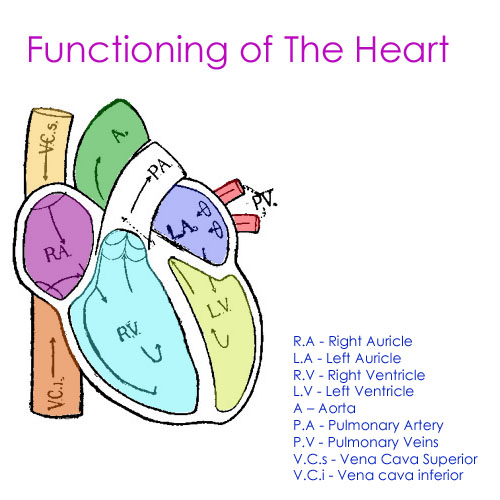Functioning of the Heart
Functioning of the Heart starts when it receives blood from the great Vein Trunk, The Vena Cava (V.C.i), the Blood pours into the receiving chamber i.e. The Right Auricle (R.A), on the right side of The Heart. Then the Blood passes between the valves of the opening into the lower chamber i.e. the Right Ventricle (R.V). When this is full, the muscles in the wall of the Ventricle contract, the Valve flaps fly up, and the blood is squirted out through the Pulmonary Artery (P.A) to the Lungs.
In the Lungs, it passes through the capillaries round the air cells, loses its carbon dioxide, takes in oxygen, and is gathered up and returned through great return pipes to the receiving chamber i.e. Left Auricle (L.A), on the Left Side of The Heart. Here it collects while the ventricle below is emptying itself, then pours down between the valve flaps through the opening to the Left Ventricle (L.V). When this is full, it contracts; the valves fly up and close the orifice; and the blood is squirted out through another valve-guarded opening, into the great main artery, The Aorta (A). The Aorta carries it, through its different branches, all over the body, where the tissues suck out their food and oxygen through the walls of the capillaries, and return it through the small veins into the large vein pipes, which again deliver it into the Vena Cava (V.C.s), and so to the right side of the heart from which we started to trace it.
Although the two sides of The Heart are doing different work, they contract and empty themselves, and relax and fill themselves, at the same time, so that we feel only one beat of the whole heart.
What is meant by Heart Beat?
When the walls of the Ventricles squeeze down to drive out their blood into the Lungs and around the body, like all other muscles they harden as they contract and strike the pointed lower end, or Apex of the Heart against the wall of the Chest, thus making what is known as the Beat of the Heart, which you can readily feel by laying your hand upon the left side of your chest, especially after you have been running or going quickly upstairs.
What is Pulse?
“As each time the Heart beats, it throws out half a teacupful of blood into the Aorta”. This Jet sends a wave of swelling down the arteries all over the body, which can be felt clearly in the small arteries of the Wrist and the Ankle. This wave of swelling occurs as often as the heart beats, is called the Pulse; and we “take” it, or count and feel its force and fullness, to estimate how fast the Heart is beating and how well it is doing its work.
“We generally use an Artery in the Wrist (Radial) for this purpose because it is one of the largest arteries in the body which run close to the surface and can be easily reached.”
Heart Beat and Pulse rate:
The Heart fills and empties itself about eighty times a minute, varying from 120 times for a Baby, and 90 times for a Child of seven, to 80 times for a Woman, and 72 times for a full-grown Man.
Some Words about Greatness of The Heart
One of the most wonderful things about the entire system of blood tubes is the way in which each particular part and Organ of the Body is supplied with exactly the amount of blood it needs. If the whole body is put to work, so that a quicker circulation of blood, with its millions of little baskets of Oxygen, is needed to enable the tissues to breathe faster, the Heart meets the situation by beating faster and harder. This, as you all know, you can readily cause by running, or jumping, or wrestling.




Share the Post